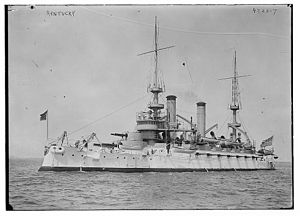USS Kentucky (BB-6)

USS Kentucky, circa 1905–08
|
|
| History | |
|---|---|
|
|
|
| Name: | Kentucky |
| Namesake: | State of Kentucky |
| Ordered: | 2 March 1885 |
| Builder: | Newport News SB&DD |
| Cost: | $4,998,119.43 |
| Laid down: | 30 June 1896 |
| Launched: | 24 March 1898 |
| Sponsored by: | Christine Bradley |
| Commissioned: | 15 May 1900 |
| Decommissioned: | 28 August 1909 |
| Identification: | Hull symbol: BB-6 |
| Recommissioned: | 23 June 1915 |
| Decommissioned: | 29 May 1920 |
| Struck: | 27 May 1922 |
| Fate: | Sold for scrap, 24 March 1923 |
| General characteristics | |
| Class and type: | Kearsarge-class pre-dreadnought battleship |
| Displacement: | 11,540 short tons (10,470 t) |
| Length: | 375 ft 4 in (114.40 m) |
| Beam: | 72 ft 3 in (22.02 m) |
| Draft: | 23 ft 6 in (7.16 m) |
| Installed power: | 5 boilers, 12,179 ihp (9,082 kW) |
| Propulsion: | 2 VTE engines, 2 propeller shafts |
| Speed: | 16.9 knots (31.3 km/h; 19.4 mph) |
| Complement: | 40 officers and 514 enlisted men |
| Armament: |
|
| Armor: |
|
USS Kentucky (BB-6) was the second and final Kearsarge-class pre-dreadnought battleship built for the United States Navy. The Newport News Shipbuilding Company of Virginia laid down her keel on 30 June 1896. She was launched on 24 March 1898, sponsored by Miss Christine Bradley, daughter of Kentucky Governor William O'Connell Bradley. She was commissioned on 15 May 1900.
In her twenty years of service, Kentucky participated in no major combat. Between 1901 and 1904, she served in East Asia, and from 1904 to 1907 she cruised the Atlantic. In 1907, she joined the Great White Fleet, returning in 1909. She was modernized in 1910, but did not operate again until 1915, when she sailed to the Mexican coast, where she stayed until 1916. From 1917 until her decommissioning on 29 May 1920, she served as a training ship. She was sold for scrap on 24 March 1923.
The Kearsarge-class battleships were designed to be used for coastal defense. They had a displacement of 11,540 short tons (10,470 t), an overall length of 375 feet 4 inches (114.40 m), a beam of 72 feet 3 inches (22.02 m) and a draft of 23 feet 6 inches (7.16 m). The two 3-cylinder vertical triple-expansion steam engines and five Scotch boilers, connected to two propeller shafts, produced a total of 12,179 indicated horsepower (9,082 kW), and gave a maximum speed of 16.897 knots (19.445 mph; 31.293 km/h).Kentucky was manned by 40 officers and 514 enlisted men, a total of 554 crew.
Kentucky, like USS Kearsarge, had two double turrets, with two 13 in (330 mm)/35 caliber guns and two 8 in (203 mm)/40 caliber guns each, stacked on two levels. The guns and turret armor were designed by the Bureau of Ordnance, while the turret itself was designed by the Bureau of Construction and Repair. The configuration caused the guns to be mounted far back in the turret, making the ports very large. Admiral William Sims claimed that as a result of the gun mounting, a shell fired into the port could reach the magazines below, disabling the guns. In addition to these guns, Kentucky carried fourteen 5 in (127 mm)/40 caliber guns, twenty 6-pounder (57 mm or 2.2 in) guns, eight 1-pounder (37 mm or 1.5 in) guns, four .30 in (7.6 mm) machine guns, and four 18-inch (460 mm) torpedo tubes.Kentucky had a very low freeboard, often making her guns unusable during bad weather.
...
Wikipedia
